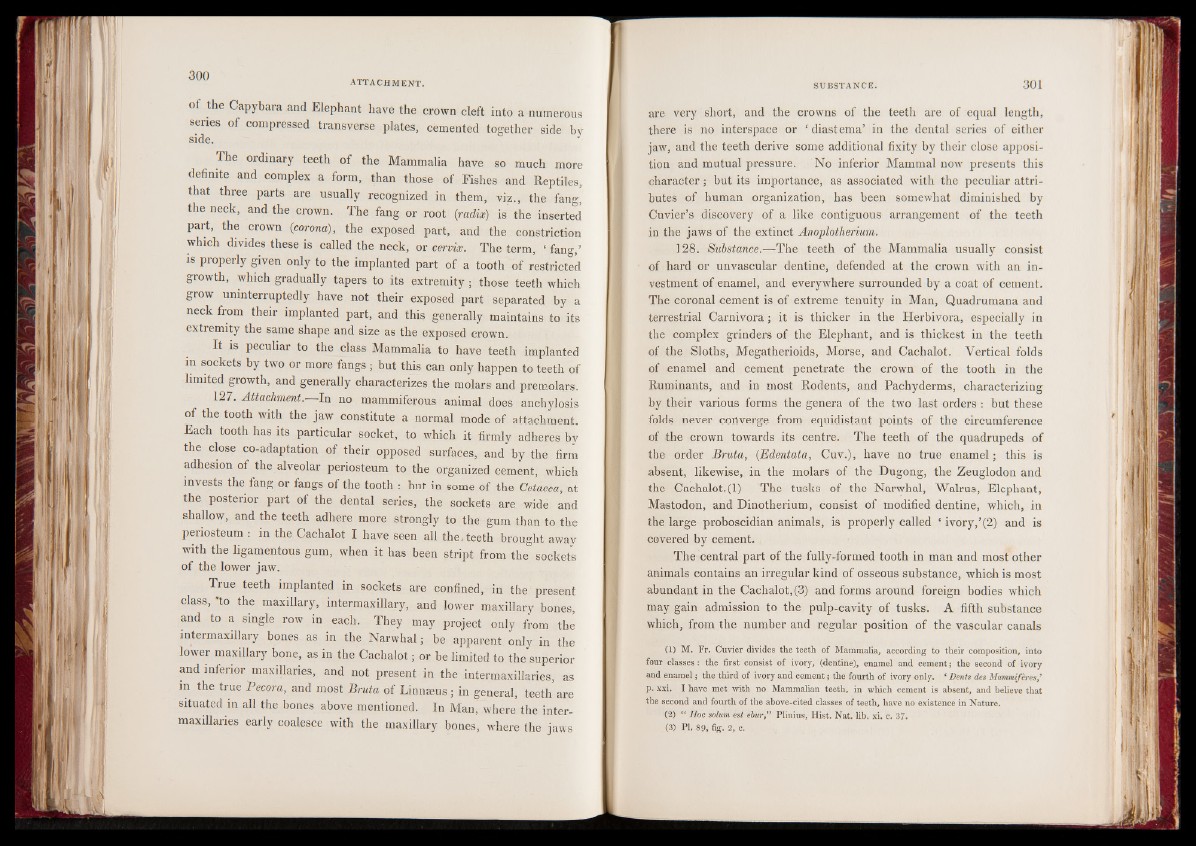
of the Capybara and Elephant have the crown cleft into a numerous
series of compressed transverse plates, cemented side. together side bv
The ordinary teeth of the Mammalia have so much more
definite and complex a form, than those of Fishes and Reptiles,
that three parts are usually recognized in them, viz., the fang,
the neck, and the crown. The fang or root {radix) is the inserted
part, the crown {corona), the exposed part, and the constriction
which divides these is called the neck, or cervix. The term, ‘ fang,’
is properly given only to the implanted part of a tooth of restricted
growth, which gradually tapers to its extremity ; those teeth which
grow uninterruptedly have not their exposed part separated by a
neck from their implanted part, and this generally maintains to its
extremity the same shape and size as the exposed crown.
It is peculiar to the class Mammalia to have teeth implanted
in sockets by two or more fangs; but this can only happen to teeth of
limited growth, and generally characterizes the molars and premolars.
127. Attachment.—In no mammiferous animal does anchylosis
of the tooth with the jaw constitute a normal mode of attachment.
Each tooth has its particular socket, to which it firmly adheres by
the close co-adaptation of their opposed surfaces, and by the firm
adhesion of the alveolar periosteum to the organized cement, which
invests the fang or fangs of the tooth : hut in some of the Cetacea, at
the posterior part of the dental series, the sockets are wide and
shallow, and the teeth adhere more strongly to the gum than to the
periosteum : in the Cachalot I have seen all the. teeth brought away
with the ligamentous gum, when it has been stript from the sockets
of the lower jaw.
True teeth implanted in sockets are confined, in the present
class, *to the maxillary, intermaxillary, and lower maxillary bones,
and to a single row in each. They may project only from the
intermaxillary bones as in the Narwhal; be apparent only in the
lower maxillary bone, as in the Cachalot; or be limited to the superior
and inferior maxillaries, and not present in the intermaxillaries, as
in the true Becora, and most Bruta of Linnaeus; in general, teeth are
situated in all the bones above mentioned. In Man, where the intermaxillaries
early coalesce with the maxillary bones, where the jaws
are very short, and the crowns of the teeth are of equal length,
there is no interspace or 1 diastema’ in the dental series of either
jaw, and the teeth derive some additional fixity by their close apposition
and mutual pressure. No inferior Mammal now presents this
character ; but its importance, as associated with the peculiar attributes
of human organization, has been somewhat diminished by
Cuvier’s discovery of a like contiguous arrangement of the teeth
in the jaws of the extinct Anoplotherium.
128. Substance.—The teeth of the Mammalia usually consist
of hard or unvascular dentine, defended at the crown with an investment
of enamel, and everywhere surrounded by a coat of cement.
The coronal cement is of extreme tenuity in Man, Quadrumana and
terrestrial Carnivora ; it is thicker in the Herbivora, especially in
the complex grinders of the Elephant, and is thickest in the teeth
of the Sloths, Megatherioids, Morse, and Cachalot. Vertical folds
of enamel and cement penetrate the crown of the tooth in the
Ruminants, and in most Rodents, and Pachyderms, characterizing
by their various forms the genera of the two last orders : but these
folds never converge from equidistant points of the circumference
of the crown towards its centre. The teeth of the quadrupeds of
the order Bruta, {Edentata, Cuv.), have no true enamel; this is
absent, likewise, in the molars of the Dugong, the Zeuglodon and
the Cachalot.(l) The tusks of the Narwhal, Walrus, Elephant,
Mastodon, and Dinothérium, consist of modified dentine, which, in
the large proboscidian animals, is properly called ‘ ivory,’(2) and is
covered by cement.
The central part of the fully-formed tooth in man and most other
animals contains an irregular kind of osseous substance, which is most
abundant in the Cachalot, (3) and forms around foreign bodies which
may gain admission to the pulp-cavity of tusks. A fifth substance
which, from the number and regular position of the vascular canals
(1) M. Fr. Cuvier divides the teeth of Mammalia, according to their composition, into
four classes : the first consist of ivory, (dentine), enamel and cement ; the second of ivory
and enamel ; the third of ivory and cement ; the fourth of ivory only, f Dents des Mammifères,’
p. xxi. I have met with no Mammalian teeth, in which cement is absent, and believe that
the second and fourth of the above-cited classes of teeth, have no existence in Nature.
(2) " Hoc solum est ebur,” Plinius, Hist. Nat. lib. xi. c. 37.
(3) PI. 89, fig. 2, c.